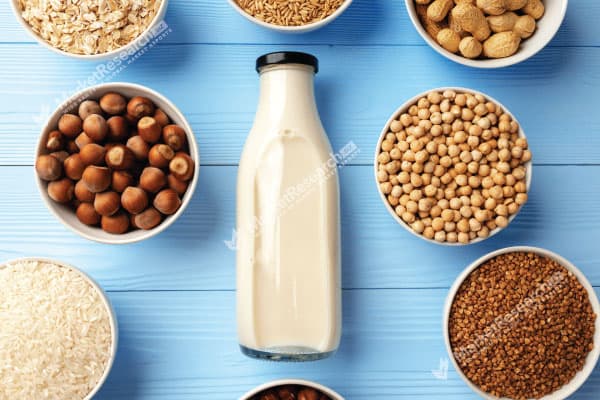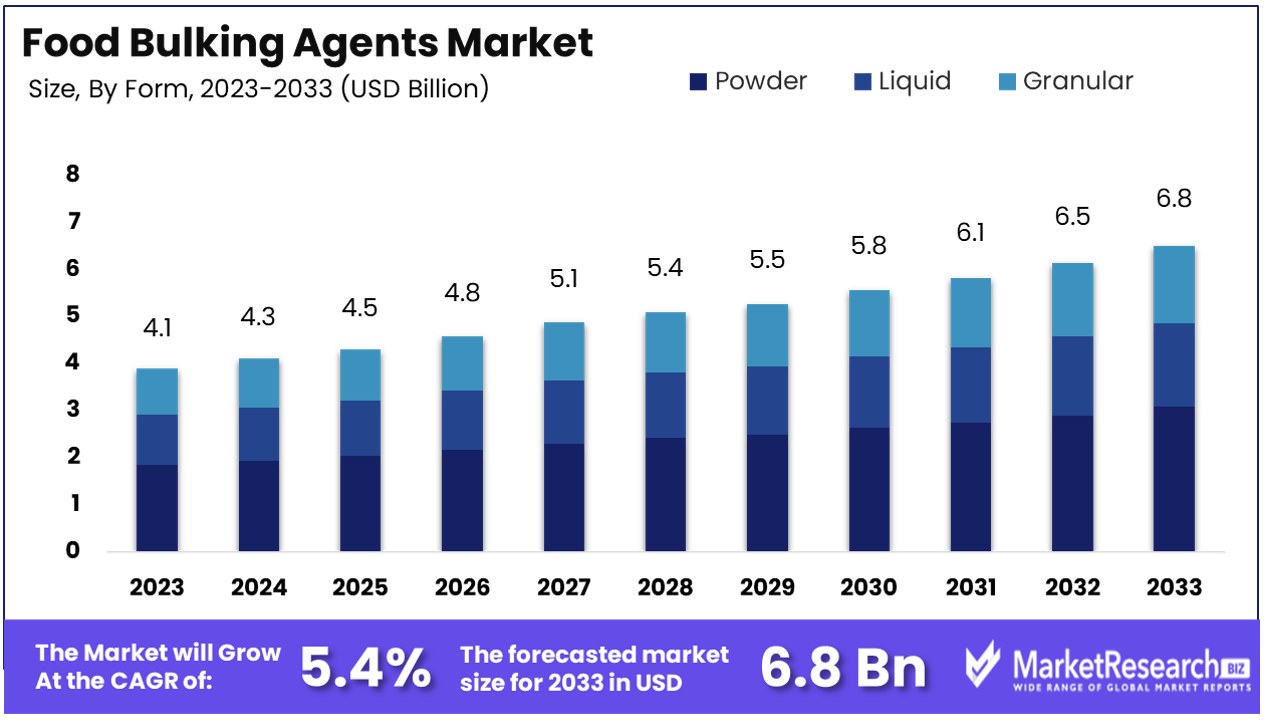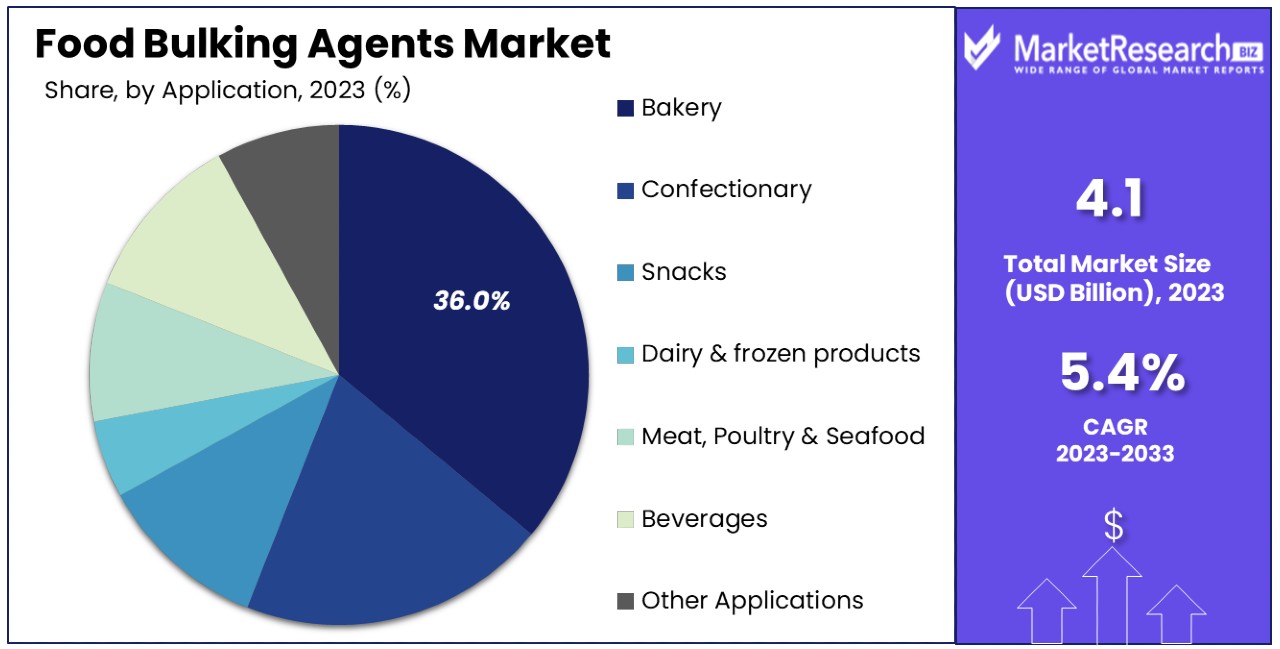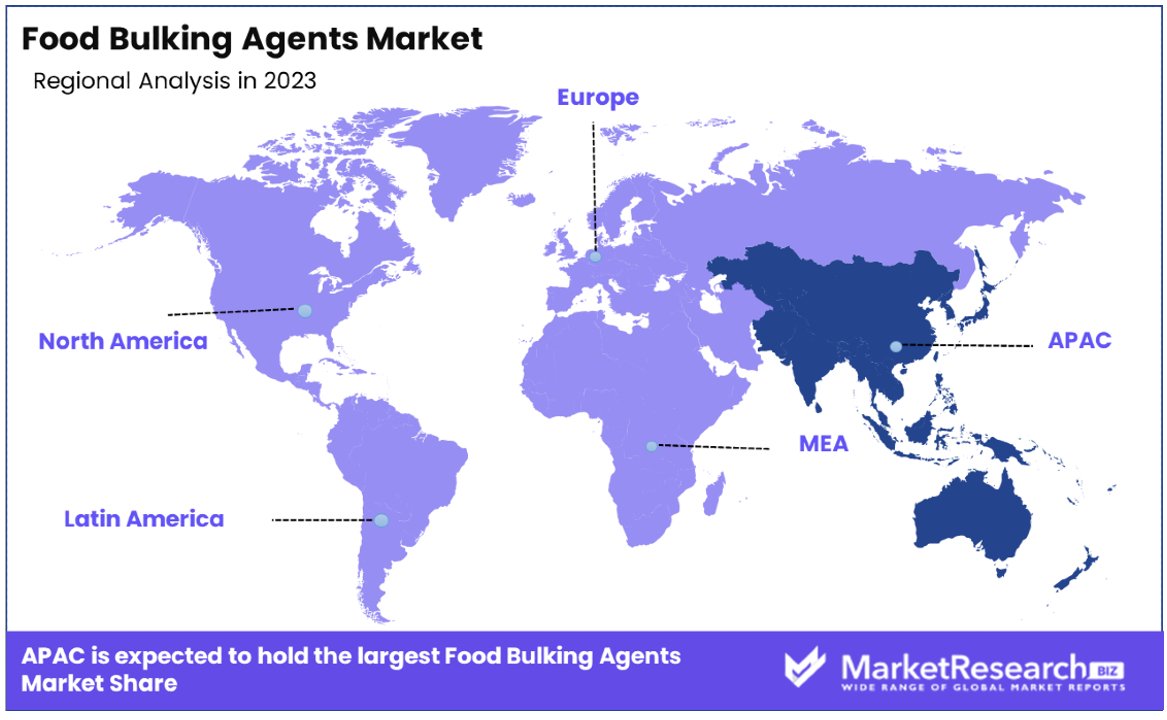
Food Bulking Agents Market Report By Product (Flavors & Enhancers, Antioxidants, Anticaking Agents, Other Product Types), By Source (Natural Bulking Agents, Synthetic Bulking Agents), By Form (Powder, Liquid, Granular), By Application (Bakery, Confectionary, Other Applications), By Region and Companies - Industry Segment Outlook, Market Assessment, Competition Scenario, Trends and Forecast 2024-2033
-
28574
-
Feb 2024
-
172
-
-
This report was compiled by Shreyas Rokade Shreyas Rokade is a seasoned Research Analyst with CMFE, bringing extensive expertise in market research and consulting, with a strong background in Chemical Engineering. Correspondence Team Lead-CMFE Linkedin | Detailed Market research Methodology Our methodology involves a mix of primary research, including interviews with leading mental health experts, and secondary research from reputable medical journals and databases. View Detailed Methodology Page
-
Quick Navigation
Report Overview
The Global Food Bulking Agents Market size is expected to be worth around USD 6.8 Billion by 2033, from USD 4.1 Billion in 2023, growing at a CAGR of 5.40% during the forecast period from 2024 to 2033.
The Food Bulking Agents Market encompasses ingredients added to food products to increase volume or mass without significantly affecting their nutritional value. These agents are vital in creating the desired texture, mouthfeel, and appearance in a variety of food items, ranging from baked goods to beverages.
They play a crucial role in reducing calorie content while maintaining the product's bulk, making them essential for the development of low-calorie, health-oriented food options. The strategic incorporation of bulking agents allows companies to innovate and enhance product offerings, aligning with consumer trends towards healthier lifestyles.

Food Bulking Agents Market is driven by the dual demands of maintaining or enhancing food product volume and texture, while also catering to the growing consumer appetite for healthy snacks, lower-calorie options. Food bulking agents, such as fibers, proteins, and certain carbohydrates, are instrumental in this regard, allowing for the formulation of products that are satisfying yet aligned with nutritional goals.
For businesses in the food and beverage industry, the strategic importance of these agents cannot be overstated. They not only facilitate product innovation by enabling the development of new, health-oriented offerings but also play a critical role in reformulating existing products to meet evolving consumer expectations. This can include everything from baked goods and snacks to dairy and meat substitutes, where the challenge is to reduce calories and enhance nutritional profiles without compromising on taste or texture.
Moreover, the Food Bulking Agents Market is characterized by its response to broader trends in health and wellness, sustainability, and clean label ingredients. As consumers become more informed and discerning about their food choices, the demand for products that can deliver on these fronts is increasing. This places added pressure on companies to source bulking agents that are not only effective but also derived from natural and sustainable sources.
Key Takeaways
- Market Growth: The Global Food Bulking Agents Market is projected to reach USD 6.8 Billion by 2033, growing at a CAGR of 5.40% from forecast period 2024 to 2033.
- Product Dominance: Flavors & Enhancers lead the market, with other key products including Antioxidants, Emulsifiers, and Sweeteners.
- Source Preference: Natural Bulking Agents hold major share over Synthetic Bulking Agents, reflecting consumer preference for natural ingredients.
- Form Diversity: Powder form is prominent, but Liquid and Granular forms also play significant roles in product formulation.
- Application Scope: Bakery is the primary application segment, followed by Confectionary, Snacks, and Dairy & Frozen Products.
- Regional Dynamics: Asia Pacific commands a 35% market share, driven by population growth and urbanization. North America, with 25% market share, benefits from health-conscious consumers and advanced food processing technologies.
- Key Players: Major players include Sayona Colors, Ningbo Pangs Chem, BASF, and Archer Daniels Midland, among others, driving innovation and market growth through strategic initiatives.
Driving Factors
Growing Demand for Low-Calorie Foods Drives Market Growth
The surge in consumer interest towards low-calorie food options significantly propels the Food Bulking Agents Market forward. As individuals become more calorie-conscious, the demand for food products that maintain taste and texture without adding extra calories has risen.
Bulking agents, such as cellulose and konjac, play a pivotal role here by mimicking the mouthfeel and volume that fats and sugars traditionally provide, but with a fraction of the calories. This shift enables manufacturers to innovate and produce low-calorie versions of popular foods, meeting consumer demands without compromising on quality or satisfaction.
Rising Health Consciousness Fuels Market Expansion
Increased awareness and interest in healthy eating habits globally are driving the growth of the Food Bulking Agents Market. As consumers become more informed about the benefits of healthy eating, there's a noticeable shift towards products that support these lifestyle choices. Bulking agents, by offering a healthier alternative to traditional fat and sugar, align perfectly with this trend.
Their ability to be used as sugar substitutes without altering the desired taste or texture of food products makes them invaluable in the creation of healthier food options. This growing health consciousness not only elevates the demand for bulking agents but also encourages manufacturers to explore and adopt these ingredients more widely, further expanding the market.
Increasing Cases of Obesity and Diabetes Propel Market Demand
The rising prevalence of lifestyle diseases, such as obesity and diabetes, has a profound impact on the Food Bulking Agents Market. With more individuals looking for ways to manage or mitigate the risks associated with these conditions, the demand for low-calorie and low-sugar foods has spiked. Bulking agents are at the forefront of this movement, enabling the production of foods that cater to these dietary needs without sacrificing taste or texture.
Their capacity to replace traditional, calorie-dense ingredients with healthier alternatives makes them a key component in the development of foods suited for individuals managing obesity and diabetes. This health-driven demand not only contributes to the market's growth but also signifies the role of food bulking agents in addressing public health challenges through dietary adjustments.
Restraining Factors
Perceptions Around Processed Foods Restrain Market Growth
Negative consumer perceptions regarding artificial additives and ingredients in processed foods pose a significant challenge to the Food Bulking Agents Market. As awareness and demand for natural and whole foods increase, the skepticism towards processed foods and their components, including bulking agents perceived as artificial, grows.
Manufacturers may face pressure to reformulate products or seek natural alternatives, potentially increasing costs and complicating production processes. Addressing consumer concerns through education and transparency about the safety and benefits of bulking agents could mitigate some of these effects, yet the overall impact remains a hurdle for market expansion.
Supply Chain Volatility Restrains Market Growth
The volatility in supply chains, characterized by fluctuating raw material prices and uneven supply, significantly impacts the Food Bulking Agents Market. Ingredients like guar gum, essential for many bulking agents, are subject to these fluctuations, which can lead to increased production costs and challenges in availability.
This volatility not only affects the stability of bulking agent production but also forces manufacturers to adjust pricing, potentially making these products less competitive. For a market dependent on consistent supply for production and innovation, these challenges can hinder growth, disrupt market dynamics, and limit the ability of companies to meet consumer demand efficiently.
Product Segment Analysis
In the diverse landscape of the Food Bulking Agents Market, the segment of "Flavors & Enhancers" emerges as the dominant sub-segment. This prominence is attributed to the increasing consumer demand for flavorful and enhanced food products that offer both taste and health benefits. As people become more health-conscious, the role of flavors and enhancers that can substitute for high-calorie ingredients without compromising taste has become crucial.
Adjacent to flavors and enhancers, other sub-segments like Antioxidants, Anticaking Agents, Emulsifiers, Acids, Sweeteners, Stabilizers, Humectants, and Other Product Types contribute to the market's diversity and expansion.
Antioxidants, for example, are gaining traction due to their health benefits and role in extending shelf life, while emulsifiers are essential for product consistency and stability in a wide range of food products. Sweeteners, both natural and synthetic, cater to the growing demand for low-calorie alternatives to sugar, reflecting the market's response to health trends.
Each of these sub-segments plays a specific role in addressing the evolving demands of the food industry, driven by consumer preferences, regulatory changes, and technological advancements. While flavors and enhancers lead the charge in market dominance, the collective growth and innovation across all sub-segments signify a robust and dynamic Food Bulking Agents Market, poised for further expansion as new applications and benefits are discovered.
Source Segment Analysis
Within the Food Bulking Agents Market, "Natural Bulking Agents" stand out as the dominant sub-segment, driven by the global shift towards natural and organic products. Consumers' increasing awareness of health and wellness has propelled the demand for natural ingredients, making natural bulking agents more appealing than their synthetic counterparts.
Synthetic Bulking Agents, while still significant, face challenges in market share due to this growing preference for natural ingredients. However, they remain vital in applications where natural alternatives may not provide the desired efficacy or cost-effectiveness. The role of synthetic agents in the market is also evolving, with innovation focused on improving their safety profile and functionality to meet regulatory and consumer demands.
The contrast between natural and synthetic bulking agents highlights a broader industry trend towards naturalization, yet underscores the complexity of meeting diverse consumer needs and regulatory standards. The ongoing development in both segments suggests a market that values both tradition and innovation, with natural bulking agents leading the growth but synthetic agents maintaining a crucial role in the food industry's future.
Form Segment Analysis
In the Food Bulking Agents Market, the "Powder" form emerges as the dominant sub-segment, primarily due to its versatility, ease of storage, and stability. Powdered bulking agents are extensively used across a wide range of food applications, from bakery goods to dairy products, owing to their ability to blend seamlessly into mixtures, providing desired volume and texture without altering the fundamental qualities of the food product.
Liquid and granular forms, while not as dominant, play significant roles in specific applications where their unique properties are required. Liquid bulking agents are crucial in beverage applications and products where moisture content is a factor, offering manufacturers the ability to adjust texture and viscosity. Granular forms find their niche in products requiring a coarse texture or slow dissolution, such as certain confectioneries and snacks.
The collective growth of these segments reflects the diverse needs of the food industry, accommodating a broad spectrum of textures, solubilities, and processing requirements. The powder segment's lead signifies the industry's preference for convenience and versatility, but the importance of liquid and granular forms underscores the market's complexity and the tailored approach needed to meet specific product development goals.
Application Segment Analysis
Within the application segment of the Food Bulking Agents Market, "Bakery" stands out as the dominant sub-segment. The bakery sector's reliance on bulking agents is driven by the need to achieve the right volume, texture, and mouthfeel in products such as bread, cakes, and pastries. Bulking agents in powdered form are particularly valued for their ability to improve the structure and stability of bakery items, contributing to the desired fluffiness and softness that consumers expect.

Following closely, the segments of Confectionary, Snacks, Dairy & Frozen Products, Meat, Poultry & Seafood Products, Beverages, and Other Applications each play a vital role in the market's dynamics. For instance, in confectionery products, bulking agents are used to provide body and texture without adding significant calories, catering to the growing demand for healthier snack options. In dairy and frozen products, they help maintain consistency and prevent crystallization, enhancing the consumer's sensory experience.
The snacks and beverages sectors also benefit from bulking agents by improving product appeal and extending shelf life, reflecting broader market trends towards healthier, longer-lasting food options. Meat, poultry, and seafood products utilize bulking agents to enhance texture and retain moisture during cooking, showcasing the ingredient's versatility across different food processing methods.
Key Market Segments
By Product
- Flavors & Enhancers
- Antioxidants
- Anticaking Agents
- Emulsifiers
- Acids
- Sweeteners
- Stabilizers
- Humectants
- Other Product Types
By Source
- Natural Bulking Agents
- Synthetic Bulking Agents
By Form
- Powder
- Liquid
- Granular
By Application
- Bakery
- Confectionary
- Snacks
- Dairy & frozen products
- Meat, Poultry & Seafood Products
- Beverages
- Other Applications
Growth Opportunities
Texture Modification Offers Growth Opportunity
The demand for texture modification in the Food Bulking Agents Market presents significant growth opportunities. As consumers increasingly seek out low-fat, low-sugar, and clean-label products, the role of bulking agents becomes pivotal in replicating the mouthfeel and texture traditionally provided by fat and sugar.
These agents allow manufacturers to maintain desirable product qualities while meeting consumer demands for healthier options. This trend not only meets current consumer preferences but also opens new avenues for product innovation and differentiation, positioning bulking agents as essential ingredients in the development of next-generation food products.
Fiber Enrichment Offers Growth Opportunity
The increased demand for fiber enrichment in foods, driven by a growing awareness of gut health benefits, highlights another area of expansion for the Food Bulking Agents Market. Fibers like inulin and bran, which double as bulking agents, offer manufacturers the dual benefits of enhancing product texture while also contributing to the nutritional profile of food products.
This alignment with consumer interest in dietary fiber for health and wellness offers a clear pathway for growth. As consumers continue to prioritize healthful eating, the demand for products that incorporate these fibrous bulking agents is expected to rise, underscoring their importance in the industry's future development.
Trending Factors
Natural Bulking Agents Are Trending Factors
Natural bulking agents are seeing a surge in popularity as consumers increasingly prefer foods with clean, understandable ingredient lists. Ingredients like guar gum, psyllium husk, and bamboo fiber are in the spotlight due to their natural origin and health benefits.
This trend is driven by a growing consumer demand for products that are perceived as healthier and more natural. The avoidance of chemical-sounding ingredients is a significant factor, with shoppers scrutinizing labels more than ever before. As a result, food manufacturers are responding by incorporating these natural alternatives into their products, making them a key trend in the food bulking agents market.
Multi-functional Ingredients Are Trending Factors
The demand for multi-functional bulking agents is on the rise as food manufacturers look for ingredients that do more than just increase volume. Ingredients that can also provide benefits like emulsification, moisture retention, and texture enhancement are particularly valued.
This multifunctionality offers manufacturers cost efficiencies and product innovation opportunities, enabling the development of products that meet multiple consumer needs at once. For instance, bulking agents that can also act as emulsifiers or stabilizers reduce the need for additional ingredients, simplifying production processes and ingredient lists.
Regional Analysis
Asia Pacific Dominates with 35% Market Share
Asia Pacific's commanding 35% share of the Food Bulking Agents Market is underpinned by its vast population and increasing health awareness. The region's robust growth in the food and beverage industry, driven by rising disposable incomes and urbanization, significantly contributes to the demand for food bulking agents. Countries like China and India are pivotal, with their burgeoning middle classes seeking healthier food options, thereby elevating the demand for natural and multi-functional bulking agents.

The region's diverse culinary traditions and rapid adoption of Western eating habits introduce a dynamic market for innovative food products. This diversity necessitates a wide array of food bulking agents to cater to varied texture and taste preferences, reinforcing the region's market dominance. Moreover, Asia Pacific's role as a major agricultural hub ensures a steady supply of natural ingredients for bulking agents, supporting sustainable market growth.
The Asia Pacific region is anticipated to maintain its dominance, driven by ongoing urbanization, health consciousness, and income growth. The expanding processed food industry and the shift towards natural ingredients are expected to further boost the market. The region's investment in food technology and innovation also positions it well for future growth, potentially increasing its market share.
- North America: Holding approximately 25% of the market share, North America's significant contribution is propelled by its health-conscious consumers and the widespread adoption of advanced food processing technologies. The region's focus on innovation and clean-label products further cements its substantial role in the market.
- Europe: Europe, with about 20% of the market share, sees its growth driven by stringent food safety regulations and a high demand for natural food additives. The region's commitment to sustainability and consumer health significantly influences its market position.
- Middle East & Africa: Commanding around 10% of the market share, the Middle East & Africa region is experiencing growth due to rapid urbanization and changing dietary habits among its population. The increasing awareness of health and wellness in these regions contributes to the market's expansion.
- Latin America: Also holding a 10% market share, Latin America benefits from its strong agricultural base and a growing processed food sector. The region's rich biodiversity and increasing investment in food technology are key drivers of its market growth.
Key Regions and Countries
- North America
- The US
- Canada
- Mexico
- Western Europe
- Germany
- France
- The UK
- Spain
- Italy
- Portugal
- Ireland
- Austria
- Switzerland
- Benelux
- Nordic
- Rest of Western Europe
- Eastern Europe
- Russia
- Poland
- The Czech Republic
- Greece
- Rest of Eastern Europe
- APAC
- China
- Japan
- South Korea
- India
- Australia & New Zealand
- Indonesia
- Malaysia
- Philippines
- Singapore
- Thailand
- Vietnam
- Rest of APAC
- Latin America
- Brazil
- Colombia
- Chile
- Argentina
- Costa Rica
- Rest of Latin America
- Middle East & Africa
- Algeria
- Egypt
- Israel
- Kuwait
- Nigeria
- Saudi Arabia
- South Africa
- Turkey
- United Arab Emirates
- Rest of MEA
Key Players Analysis
In the Food Bulking Agents Market, a diverse array of companies from global giants to specialized regional players significantly shapes the competitive landscape. Sayona Colors and Ningbo Pangs Chem represent the market's color spectrum, offering innovative solutions that cater to the aesthetic appeal of food products. Their strategic positioning emphasizes the importance of visual enhancement in food appeal, impacting market trends toward visually appealing consumables.
Sumimoto Technology and Zhengzhou Natural Chemical highlight the industry's shift towards natural and sustainable bulking agents, responding to the growing consumer demand for clean-label products. These companies are pivotal in driving innovation in natural ingredient sourcing and processing technologies, thereby influencing market dynamics towards eco-friendly and health-conscious products.
Acroyali and Adhya Biotech, along with Flavors & Enhancers, focus on the sensory aspects of food, enhancing taste and texture without compromising health. Their roles underscore the market's evolution towards multifunctional additives that deliver on consumer expectations for both flavor and nutritional value.
Global behemoths like BASF, Danisco (part of DuPont), Archer Daniels Midland, and Associated British Foods bring a comprehensive portfolio of food additives, including bulking agents, to the table. Their extensive research and development capabilities, along with a broad distribution network, set industry standards for quality and innovation. These companies' strategic investments in new product development and global market expansion play a critical role in shaping market trends and consumer preferences.
Market Key Players
- Sayona Colors
- Ningbo Pangs Chem
- Sumimoto Technology
- Zhengzhou Natural Chemical
- Acroyali
- Adhya Biotech
- Flavors & Enhancers
- BASF
- Danisco
- Archer Daniels Midland
- Associated British Foods
- Other players
Recent Developments
- On June 2023, T. Hasegawa USA has recently introduced two new flavor enhancer technologies, namely HASEAROMA™ and ChefAroma™, aimed at creating more authentic taste experiences in food and beverages.
- On Dec 2021, Omya, a Swiss ingredients producer, has launched Omyafood 120, an anti-caking agent designed to enhance powder handling and processing. This non-nano anti-caking solution is based on functionalized calcium carbonate (FCC) particles that have undergone a patented recrystallization process, resulting in a new mineral composition and structure.
Report Scope
Report Features Description Market Value (2023) USD 4.1 Billion Forecast Revenue (2033) USD 6.8 Billion CAGR (2024-2033) 5.40% Base Year for Estimation 2023 Historic Period 2018-2023 Forecast Period 2024-2033 Report Coverage Revenue Forecast, Market Dynamics, Competitive Landscape, Recent Developments Segments Covered By Product (Flavors & Enhancers, Antioxidants, Anticaking Agents, Emulsifiers, Acids, Sweeteners, Stabilizers, Humectants, Other Product Types), By Source (Natural Bulking Agents, Synthetic Bulking Agents), By Form (Powder, Liquid, Granular), By Application (Bakery, Confectionary, Snacks, Dairy & frozen products, Meat, Poultry & Seafood Products, Beverages, Other Applications) Regional Analysis North America - The US, Canada, & Mexico; Western Europe - Germany, France, The UK, Spain, Italy, Portugal, Ireland, Austria, Switzerland, Benelux, Nordic, & Rest of Western Europe; Eastern Europe - Russia, Poland, The Czech Republic, Greece, & Rest of Eastern Europe; APAC - China, Japan, South Korea, India, Australia & New Zealand, Indonesia, Malaysia, Philippines, Singapore, Thailand, Vietnam, & Rest of APAC; Latin America - Brazil, Colombia, Chile, Argentina, Costa Rica, & Rest of Latin America; Middle East & Africa - Algeria, Egypt, Israel, Kuwait, Nigeria, Saudi Arabia, South Africa, Turkey, United Arab Emirates, & Rest of MEA Competitive Landscape Sayona Colors, Ningbo Pangs Chem, Sumimoto Technology, Zhengzhou Natural Chemical, Acroyali, Adhya Biotech, Flavors & Enhancers, BASF, Danisco, Archer Daniels Midland, Associated British Foods, Other players Customization Scope Customization for segments, region/country-level will be provided. Moreover, additional customization can be done based on the requirements. Purchase Options We have three licenses to opt for: Single User License, Multi-User License (Up to 5 Users), Corporate Use License (Unlimited User and Printable PDF) -
-
- Sayona Colors
- Ningbo Pangs Chem
- Sumimoto Technology
- Zhengzhou Natural Chemical
- Acroyali
- Adhya Biotech
- Flavors & Enhancers
- BASF
- Danisco
- Archer Daniels Midland
- Associated British Foods
- Other players




